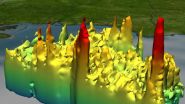(Press-News.org) A simple and effective portable tool to predict avian flu outbreaks on farms has been created by University of Guelph researchers.
U of G researchers devised a real-time way to analyze chickens and other farm birds for avian flu. The tool uses a small blood sample and relies on a simple chemical colour change to see not only whether a chicken has avian flu but also what viral strain is involved.
Current tests require samples to be sent to a lab, where it can take eight hours to a couple of days to yield results. That's too long, said Prof. Suresh Neethirajan, School of Engineering.
"Treatment, especially when dealing with humans who have been infected, needs to start as soon as possible," he said.
"This test only needs two to three minutes to incubate, and then you get the results immediately. Not only that, but it is more cost-effective. Conventional techniques are time-consuming and labour-intensive, and require special facilities and expensive laboratory instruments."
A study about the device will appear in an upcoming issue of the scientific journal Sensors, published by Molecular Diversity Preservation International (MDPI).
This week, Canadian officials placed eight farms in southern Ontario under quarantine after an avian influenza outbreak caused the sudden deaths of thousands of birds over several days.
Preliminary testing on the strain was conducted at U of G's Animal Health Lab.
An outbreak of avian flu also took place in Canada in January and December of 2014.
Neethirajan and post-doctoral researcher Longyan Chen wanted to create a test that could be used by anyone, even a non-scientist.
"That is why we designed it so that the final colour changes based on what type of influenza it is, and it can differentiate between a human strain and a bird strain," said Neethirajan.
"It's critical to get out front of any outbreaks. There are many strains, and we need to know the source of the flu. The identification of the strain determines what treatment options we should use."
The device uses gold nanoparticles (microscopic particles) and glowing quantum dots. The researchers developed a novel approach for rapid and sensitive detection of surface proteins of viruses from blood samples of turkeys.
The new nanobiosensor can detect the strains of H5N1 and H1N1. The most recent outbreak was from H5N2, which is similar to H5N1, Neethirajan said. With some architecture modifications, the developed biosensing technique has the potential to detect the H5N2 strain as well, he said.
The subtype H1N1 is human adapted while most H5 are avian oriented, Neethirajan added.
"We're creating a rapid animal health diagnostic tool that needs less volume of blood, less chemicals and less time. We will be able to determine, almost immediately, the difference between virus sub-strains from human and avian influenza."
INFORMATION:
CLEMSON, S.C. -- You're going to have to think very small to understand something that has the potential to be very big.
A team of researchers, including Kyle Brinkman of Clemson University, developed a material that acts as a superhighway for ions. The material could make batteries more powerful, change how gaseous fuel is turned into liquid fuel and help power plants burn coal and natural gas more efficiently.
The team reported its findings Friday in the journal Nature Communications.
Ye Lin, Shumin Fang and Fanglin Chen, all of the University of South Carolina, ...
Strategic partnering has become commonplace when introducing innovations to systems markets. In standards battles, network affiliation has been used as a market signal to create confidence in a format's success. This paper's authors thus develop and test a model aimed at finding the right partners to sponsor an innovative technology. The results suggest that company characteristics shape expectations about a system's future value and the likelihood of its survival. Partners that have proven successful in adjacent industries are especially suited to drive diffusion. Attracting ...
Major steps forward in the use of plants for renewable materials, energy and for building construction could soon arise, thanks to a key advance in understanding the structure of wood.
The step forward follows research by the Universities of Warwick and Cambridge and the unexpected discovery of a previously unknown arrangement of molecules in plant cell walls.
The paper describing this work was Editors' Choice for the American Chemical Society for March 25th.
The researchers investigated the polymer xylan, which comprises a third of wood matter.
Professor Ray ...
A study by researchers at The University of Manchester and the University of Liverpool has examined the psychological treatment of more than 300 people suffering from psychosis, showing that, whatever the therapy, it is the relationship between the patient and therapist which either improves or damages wellbeing.
The research relates to one of the more controversial ideas in psychotherapy research - the Dodo bird conjecture. Named after a bird in Alice's Adventures in Wonderland which sent several characters on a race and then declared them all winners, this conjecture ...
Consumers whose drinking water can be contaminated by the release of untreated wastewater after heavy rains face increased risk for gastrointestinal illness, according to a report in the journal Environmental Health Perspectives.
"Combined" sewer systems collect both sewage and stormwater runoff on the way to treatment facilities. When heavy rainfall fills these systems beyond their capacity, untreated wastewater can back up into homes. To reduce the risk of home flooding during heavy precipitation, municipalities often discharge some of the untreated flow into nearby ...
COLUMBUS, Ohio--A new study provides an inside look at the most powerful explosions in the universe: gamma-ray bursts.
These rare explosions happen when extremely massive stars go supernova. The stars' strong magnetic fields channel most of the explosion's energy into two powerful plasma jets, one at each magnetic pole. The jets spray energetic particles for light-years in both directions, at close to light speed.
On Earth, we detect bits of the resulting debris as gamma rays. Researchers also suspect--but haven't been able to prove conclusively--that GRBs are the source ...
Scientists from South Carolina's leading public universities--the University of South Carolina and Clemson University--have made a discovery that could dramatically improve the efficiency of batteries and fuel cells.
The research, which is published in the journal Nature Communications, involves improving the transport of oxygen ions, a key component in converting chemical reactions into electricity. The team studied a well-known material, gadolinium doped ceria (GDC), which transports oxygen ions and is currently in use as a solid oxide fuel cell electrolyte. Through ...
Washington, DC (April 10, 2015) - Using tech, like iPads, in schools has turned into a heated political debate. Los Angeles infamously spent $1.3 billion on a program to give iPads to each student that has subsequently been plagued with problems. In the United Kingdom the head of the National Association of Head Teachers claimed he was dubious about using tech as a teaching aid in non-IT classes. One solution could be using shared tech in classrooms. A promising study by a researcher at Northwestern University found that kindergartners in classes with shared iPads significantly ...
In 1997 when the Tropical Rainfall Measuring Mission, or TRMM, was launched, its mission was scheduled to last just a few years. Now, 17 years later, the TRMM mission has come to an end. NASA and the Japan Aerospace Exploration Agency (JAXA) stopped TRMM's science operations and data collection on April 8 after the spacecraft depleted its fuel reserves.
TRMM observed rainfall rates over the tropics and subtropics, where two-thirds of the world's rainfall occurs. TRMM carried the first precipitation radar flown in space, which returned data that were made into 3-D imagery, ...
In one of the most comprehensive multi-observatory galaxy surveys yet, astronomers find that galaxies like our Milky Way underwent a stellar "baby boom," churning out stars at a prodigious rate, about 30 times faster than today.
Our sun, however, is a late "boomer." The Milky Way's star-birthing frenzy peaked 10 billion years ago, but our sun was late for the party, not forming until roughly 5 billion years ago. By that time the star formation rate in our galaxy had plunged to a trickle.
Missing the party, however, may not have been so bad. The sun's late appearance ...

